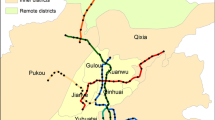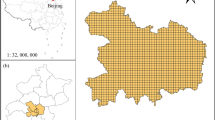Abstract
Taxicab is an important mode in urban transportation system, while the role of taxicabs, especially the relationship with metro system has not been fully studied. This study aims at exploring the factors influencing the role played by taxicabs in Shanghai, China. Firstly, taxi trips are categorized into three types, namely metroreplaceable (MR), metro-extending (ME) and metro-supplement (MS) ones. Then, the tendency of travelers towards taxi or metro at a specific metro station is proposed and calculated on the basis of MR taxi trips and metro trips. Factors influencing the tendency are investigated through semi-parametric regression models, with the results indicating that the most significant factors and the influencing radii during the peak and off-peak hours are different. Some built environment factors, such as the number of hospitals and government agencies, have significant positive relationship with the tendency in the time periods. Furthermore, land use related factors, such as the increase of forestry and commercial land, generally promote taxi-hiring in the off-peak hours, while they have a negative impact during the peak hours. Findings of this study can assist governments and policy makers to understand the impact of built environment and land use on trip patterns, and thus may contribute to more reasonable policies and optimized urban planning, which may promote modal switch from taxi to subway.
Similar content being viewed by others
References
KING D A, PETERS J R, DAUS M W. Taxicabs for improved urban mobility: Are we missing an opportunity [C]//Transportation Research Board 91st Annual Meeting. Washington, USA: Transportation Research Board, 2012: No.12-2097.
NING Y M, HUANG S L. The hierarchical system and its changing characteristic of the retail centers in Shanghai City [J]. Areal Research and Development, 2005, 24(2): 15–19 (in Chinese).
QIAN X W, ZHAN X Y, UKKUSURI S V. Characterizing urban dynamics using large scale taxicab data [C]//Engineering and Applied Sciences Optimization. Cham, Switzerland: Springer, 2015: 17–32.
ZHANG D Z, SUN D(J), PENG Z R. A comprehensive taxi assessment index using floating car data [J]. Journal of Harbin Institute of Technology (New Series), 2014, 21(1): 7–16.
HUANG Y Z, SUN D(J), TANG J Y. Taxi driver speeding: Who, when, where and how? A comparative study between Shanghai and New York [J]. Traffic Injury Prevention, 2018, 19(3): 311–316.
NIAN G Y, LI Z, ZHU W Q, et al. Analyzing behavior differences of occupied and non-occupied taxi drivers using floating car data [J]. Journal of Shanghai Jiao Tong University (Science), 2017, 22(6): 682–687.
SUN D(J), ZHANG C, ZHANG L H, et al. Urban travel behavior analyses and route prediction based on floating car data [J]. Transportation Letters: The International Journal of Transportation Research, 2014, 6(3): 118–125.
YANG C, GONZALES E J. Modeling taxi trip demand by time of day in New York City [J]. Transportation Research Record: Journal of the Transportation Research Board, 2014, 2429(1): 110–120.
QIAN X W, UKKUSURI S V. Spatial variation of the urban taxi ridership using GPS data [J]. Applied Geography, 2015, 59: 31–42.
LIU Y, WANG F H, XIAO Y, et al. Urban land uses and traffic ‘source-sink areas’: Evidence from GPSenabled taxi data in Shanghai [J]. Landscape and Urban Planning, 2012, 106: 73–87.
DONG Y M, PAN C L,WEI Y P. Influence of land-use and traffic-supply on travel pattern of shopping-mall in nine sub-districts of Hangzhou, China [J]. Journal of Zhejiang University (Science Edition), 2013, 40(1): 93–101 (in Chinese).
SUN D(J), CHEN S K, ZHANG C, et al. A bus route evaluation model based on GIS and super-efficient data envelopment analysis [J]. Transportation Planning and Technology, 2016, 39(4): 407–423.
ZHANG K S, SUN D(J), SHEN S W, et al. Analyzing spatiotemporal congestion pattern on urban roads based on taxi GPS data [J]. Journal of Transport and Land Use, 2017, 10(1): 675–694.
WANG H W, PENG Z R, LU Q C, et al. Assessing effects of bus service quality on passengers’ taxi-hiring behavior [J]. Transport, 2018, 33(4): 1030–1044.
HOCHMAIR H H. Spatio-temporal pattern analysis of taxi trips in New York City [J]. Transportation Research Record: Journal of the Transportation Research Board, 2016, 2542: 45–56.
CERVERO R. Transit-based housing in California: Evidence on ridership impacts [J]. Transport Policy, 1994, 1(3): 174–183.
EWING R, CERVERO R. Travel and the built environment: A meta-analysis [J]. Journal of the American Planning Association, 2010, 76(3): 265–294.
WANG F R, ROSS C L. New potential for multimodal connection: Exploring the relationship between taxi trips and transit in New York City (NYC) [J]. Transportation, 2017. https://doi.org/10.1007/s11116-017-9787-x (published online).
LI M Y, DONG L, SHEN Z J, et al. Examining the interaction of taxi and subway ridership for sustainable urbanization [J]. Sustainability, 2017, 9(2): 242.
SUN D(J), PENG Z R, SHAN X F, et al. Development of web-based transit trip-planning system based on service-oriented architecture [J]. Transportation Research Record: Journal of the Transportation Research Board, 2011, 2217(1): 87–94.
RUPPERT D, WANDM P, CARROLL R J. Semiparametric regression during 2003–2007 [J]. Electronic Journal of Statistics, 2009, 3: 1193–1256.
LI B B. The multinomial logit model revisited: A semi-parametric approach in discrete choice analysis [J]. Transportation Research Part B, 2011, 45: 461–473.
Author information
Authors and Affiliations
Corresponding author
Additional information
Foundation item: the Shanghai Municipal Natural Science Foundation (No. 17ZR1445500), and the Humanities and Social Sciences Foundation of Ministry of Education in China (Nos. 18YJCZH011 and 19YJAZH077)
Rights and permissions
About this article
Cite this article
Ye, Y., Sun, J. & Luo, J. Analyzing Spatio-Temporal Distribution Pattern and Correlation for Taxi and Metro Ridership in Shanghai. J. Shanghai Jiaotong Univ. (Sci.) 24, 137–147 (2019). https://doi.org/10.1007/s12204-019-2051-0
Received:
Published:
Issue Date:
DOI: https://doi.org/10.1007/s12204-019-2051-0




